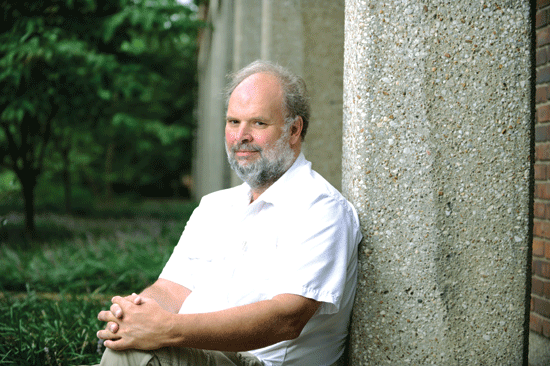Fields medalist brings informal style to Vanderbilt

When Vaughan Jones was 5 years old, he made his first mathematical discovery.
“I was learning the addition tables and realized that if one plus one equals two, then 100 plus 100 must equal 200 – something that people have since told me was a non-trivial step for a 5-year-old,” Jones recalled.
Growing up in Auckland, New Zealand, Jones followed his mathematical muse through grammar school to the University of Auckland, where he received bachelor’s and master’s degrees in science with first class honors.
At this point Jones faced a difficult choice: stay in New Zealand, where the opportunities to follow his academic interests were limited, or study abroad. When he received a Swiss government scholarship to study in Geneva, he decided to take the adventurous course.
“If I had known that I would never move back to New Zealand, I don’t think I would have left,” Jones said. “[rquote]I still feel very much the New Zealander. I’m a Kiwi at heart and get back as frequently as I can.”[/rquote]
When he arrived in Geneva in 1974, Jones entered the École de Physique to study physics. He transferred to the École des Mathématiques a year and a half later, where the prominent Swiss mathematician André Haefliger supervised him. In 1979, Jones was awarded his Docteur ès Sciences (Mathématiques).
While studying in Geneva Jones met his future wife, American Fulbright scholar Martha Myers, at a ski camp for foreign students. With an American wife it seemed natural to look for positions in the United States. He got his introduction to American popular culture while living in Los Angeles, where he spent an academic year at UCLA. He next went to the University of Pennsylvania until 1984, when he moved back to California to participate in a special research year at the newly created Mathematical Sciences Research Institute. While there he accepted an appointment as a full professor at UC-Berkeley.
In 1984 Jones was working on a problem related to the foundations of quantum mechanics, the mathematics that describe the behavior of matter on a small scale. Physicists have used some of his formulae in attempts to explain the strange properties – including superconductivity – that occur at very low temperatures.
In the course of this study, Jones discovered an unexpected link between statistical mechanics, a form of mathematics used to study complex systems with large numbers of components, and knot theory, a mathematical field that dates back to the 19th century. Specifically, he found a new mathematical expression – now known as the Jones polynomial – that distinguishes between different kinds of knots. This was the first advance of its type since American mathematician J.W. Alexander created the first knot polynomial in 1928. Mathematicians quickly discovered that the two polynomials could be combined to make a third polynomial that provides a more complete representation of knots than either provided alone.
In 1990, the discovery won Jones the Fields Medal, considered the Nobel Prize of mathematics. It is awarded every four years to mathematicians not more than 40 years old for outstanding discoveries in mathematics. The more mathematicians studied Jones’ breakthrough, the more remarkable it became.
In a lecture on Jones’ work that she gave at the 1990 meeting of the International Congress of Mathematics, Columbia mathematician Joan Birman said, “[lquote]As time went on, it became clear that his discovery had to do in a bewildering variety of ways with widely separated areas of mathematics and physics.”[/lquote]
In fact, Jones discovery has formed the basis for a whole new branch of mathematics called quantum topology that has allowed physicists to characterize complicated three-dimensional spaces filled with holes and loops. His ideas are also being used by molecular biologists studying DNA. It turns out that the mechanisms used by cells to untangle the double-helix strands of DNA during replication are strikingly similar to the mathematical moves used to generate Jones polynomials.
Jones is known for his informal style. When he delivered the lecture associated with the Fields Medal at the ICM – the biggest meeting of mathematicians in the world – he wore the jersey of the New Zealand All Blacks rugby team.
When he was living in the Bay area, he took up windsurfing as a hobby and then migrated to kite boarding. Now that Jones is living in landlocked Nashville, he intends to schedule some trips to good kite boarding sites in Texas and the Caribbean, though he says there may be possibilities on Percy Priest Lake.
When his move to Vanderbilt was announced, mathematics chair Dietmar Bisch, who has collaborated with Jones for more than 15 years, said, “His presence will enhance our research profile enormously and give our students and postdocs a chance to learn from one of our pre-eminent mathematicians.”
See the complete list of new faculty for 2011-12.